Sewing Supplies Part 1
by Mrs. Moriya Chesler
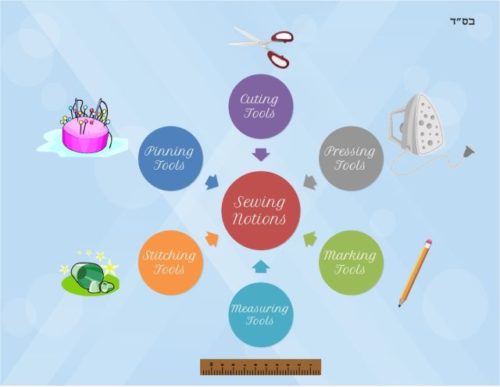
Sewing Notions, (c) by Mrs Moriah C.
Now that you are familiar with your sewing machine and how to thread it, we will go on to learn about the supplies that we need in addition to the machine for sewing. Basically, sewing supplies or notions can be grouped in six categories.
- Stitching Tools
- Cutting Tools
- Measuring Tools
- Marking Tools
- Pinning Tools
- Pressing Tools
Hopefully, the picture above will be a memory aid for you. This article is going to focus on the first three items in the list.
Stitching Tools
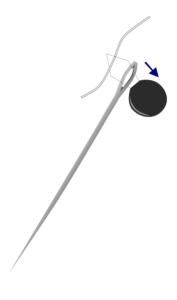
Needle Threader by Shyamal | Wiki Commons
There are many ways to make a garment; some can be completely sewn with a sewing machine and/or serger, others require a combination of a sewing machine/serger and hand stitching. Hand stitching is required depending on the construction techniques of a garment. With hand-stitching, we will need hand-sewing needles, a thimble and sometimes a needle-threader for those of us with weaker eyesight.
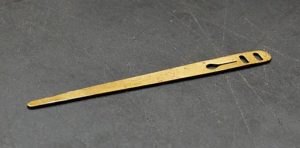
If we will be inserting elastic, cording or trimming into a garment, we will find a bodkin very useful. A bodkin may resemble a huge blunt needle with a giant eye or it may appear flat with holes to insert elastic, ribbon, tape or any other flat, narrow trim. Some dressmakers use a safety pin instead of a bodkin for this purpose.
Another useful tool is a loop turner which is a long metal rod with a hook on one end and a ring on the other end. Its function is to turn a narrow tubing inside out.
A rather hard-to-find item is called a ‘pointer’. It has a rounded end and a pointy tip on the other. It is sometimes made of wood, bamboo or plastic. The rounded end is used to smooth seam lines when ironing and the pointed end is used to push out the corners of a garment, such as a collar, pocket or hem. Some dressmakers use the ends of a chopstick for this purpose.
Cutting Tools
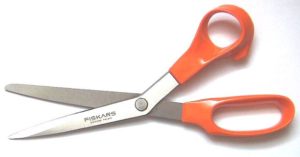
Fiskar Dressmaker’s Shears Public Domain
Garment making is impossible without cutting tools. The most important tool is the scissors, but there are so many types of scissors. Don’t use hair-cutting scissors or paper-cutting scissors to cut your fabric. They are not meant for fabric and will not do an adequate job. For dressmaking, you will need a good pair of dressmaker’s shears and reserve it only for cutting fabric. If you use it both for fabric and other medium such as paper, the blades will become dull. Shears have long blades and bent handles of unequal size and shape. One handle fits your thumb and the other bigger handle fits the other fingers.
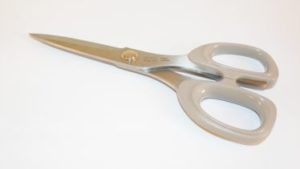
Small Scissors by Skalunda | morguefile
Besides a pair of shears, you will also need a pair of good old scissors. These have small round handles and shorter blades (4 to 6 inches). You will find it easier to use for trimming seams, clipping curves and cutting corners.
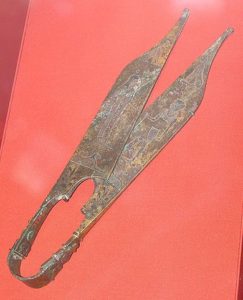
Ancient Thread Clipperby Ytrottier | Wiki Commons
Here is a picture of an ancient pair of scissors called the thread clipper found in Egypt.
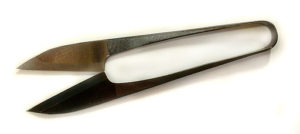
You may find a modern version of this useful for snipping thread ends or stitches.
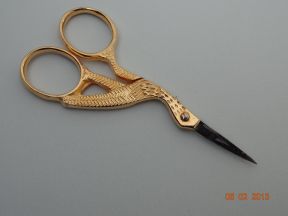
Embroidery Scissors by lilbet | morguefile
A very small version of scissors called the embroidery scissors are only 3 to 4 inches long with very pointy and sharp blades. It is not necessary to have this unless you also do embroidery, but you can use it for cutting delicate holes such as in making buttonholes and to rip fine stitches.
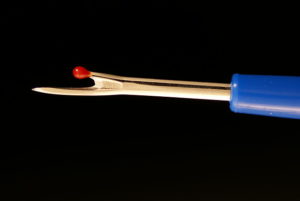
No dressmaker would be happy without a seam ripper. A seam ripper is very sharp so you will have to be very careful with its use. It is a small instrument with a sharp blade that when used correctly helps you lift the thread off from the fabric instead of cutting the fabric. Its sharp end is also useful for cutting a slit in the fabric to make a buttonhole.
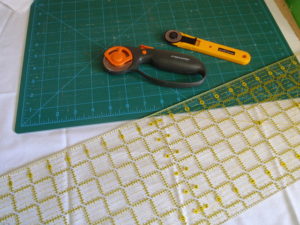
Rotary_Mat,_Ruler_and_Cutters by CWalley | Wiki Commons
You will probably not need this, unless you do a lot of quilting and need precision in cutting geometrical shapes. It is called a rotary cutter and it looks like a pizza cutter. It comes with a very sharp blade and the cost of blade replacement can be a problem with prolonged use. If you want to use a rotary cutter, you will also need to get a ‘self-healing’ mat, otherwise the cutter will destroy the surface of your cutting table.
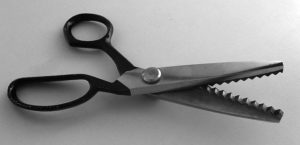
Pinking Shears by Magnus Manske | Wiki Commons
Another pair of shears that you may want to own is called the pinking shears. It has serrated edges that look like shark’s teeth on both blades and is quite heavy to handle. It’s use is not for cutting fabrics like a dressmaker’s shears, but for trimming away seams to prevent them from fraying. Woven fabrics, which we will learn, b’ezras Hashem (with help from Hashem), in the near future, tend to fray after cutting. Fraying happens when the woven threads start coming loose. Don’t you find that annoying sometimes, especially on Shabbos? You can’t pull out the thread and you have to constantly hide it somewhere under your garment. Besides being heavy and hard to handle, it is also costly to own. But if you can afford to have one, you will have much use for it besides trimming seams, I can assure you.
Measuring Tools
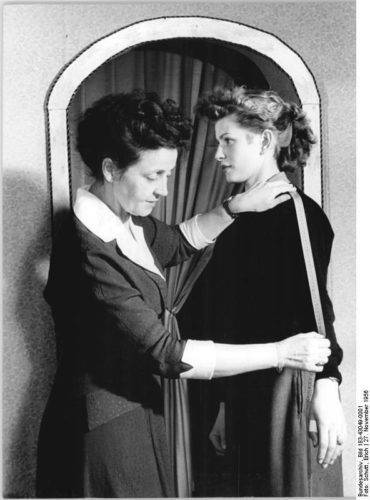
Taking Body Measurements, Public Domain
You have probably used measuring tools for most of your life as a student. Your handy dandy ruler is something you can’t live without. For dressmaking, a tape measure is just as important as a ruler, if not more. The tape measure, due to its flexibility, is ideal for taking body measurements. How often do you use your ruler to measure the length of skirts that will tzniusly (modestly) cover your knees? Your tape measure will be your best friend in this sewing course. If you carry it with you in your purse when going shopping for clothing, you will be thankful that you have it. Once you are comfortable taking body measurements you will use the tape measure to measure the length of skirts and blouses and dresses and compare them with your personal measurement. That is more accurate than trying to place a garment next to you to see if it will be tzanua (modest) on you.

Yardstick, Public Domain
If you will be drafting a skirt pattern, and for us, that means a long modest skirt pattern, we will also need a yardstick or meter stick. A yardstick measures 36 inches and is more than enough for drafting a skirt lengthwise. It is also helpful for measuring yardage for fabric that you will need for your pattern.
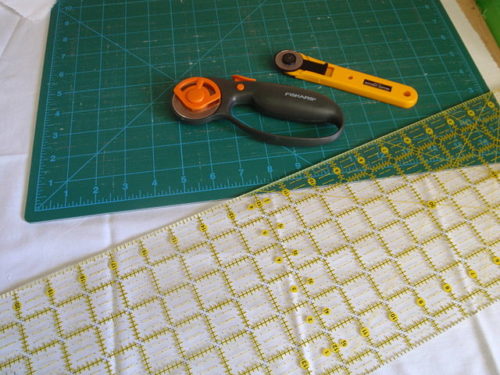
Rotary_Mat,_Ruler_and_Cutters by CWalley | Wiki Commons
You may also find a transparent ruler that is used often in quilting to be helpful in pattern drafting and transferring lines for button holes, pleats, tucks and bias strips. I find it extremely useful in adding seam allowances to my paper patterns.
A seam gauge, which is a short, six-inch ruler with clear marked notches and a moveable lever to accurately measure small measurements for seam and hem widths, is another wonderful measuring tool to own.
